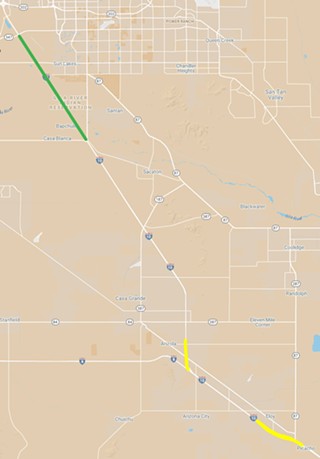If you frequently travel the Tucson/Phoenix corridor, you among many other Arizona residents probably wonder why I-10 switches between two and three lanes intermittently, causing frequent traffic jams and headaches. Well, your suffering is coming to an end — kind of.
In 2016, news broke that the Arizona Department of Transportation would receive a $54 million federal FASTLANE grant to improve areas of I-10 between Tucson and Phoenix. With the help of these funds, road-widening construction began last month on I-10, south of Casa Grande between Earley Road and the I-8 Interchange (mileposts 196 to 200) and between Eloy and Picacho Peak (mileposts 209 to 213).
The $36.6 million construction project is expected to finish by August 2019, and ADOT anticipates limited closures and lane restrictions as well as some overnight restrictions during this time.
According to Tom Herrmann, ADOT's public information officer, construction crews will build into the road's existing median to add an additional two lanes, creating a six-lane highway—three going in each direction. They will also restructure a bridge near Jimmie Kerr Boulevard.
These sections are the last areas between Casa Grande and Tucson that are still only two lanes wide on each side. This area is also significant because the highway between Eloy and Picacho Peak is prone to dust storms and dangerous driving conditions.
Herrmann said ADOT conducted a study of all dust-related traffic crashes on I-10 between Phoenix and Tucson from 2010 and 2015. They found that there were 85 dust-related crashes in those five years and 43 of them happened between mile-markers 212 and 214.
To help fix this hazard, the expansion will include new dust-detecting technology that can inform drivers of low-visibility conditions in real time. Constuction crews will install electronic speed limit signs that adjust between 35 mph to 75 mph, electronic message boards, camera networks and other improvements to help drivers stay safe.
Casa Grande Mayor Craig McFarland is excited about these new updates to the highway but expressed concern that highway widening is desperately needed on the stretch of I-10, north of Casa Grande leading into Phoenix. He says that specific area has a heavier amount of congestion that creates traffic problems on a regular basis. With limited funds for road projects, McFarland wishes ADOT would work on expanding the northern section rather than where it is currently taking place.
"It narrows down to two lanes just for a little bit and then it opens back up," McFarland said of the highway between Eloy and Picacho Peak. "And there really isn't as much traffic between Casa Grande and Tucson as there is between Casa Grande and Phoenix."
According to ADOT's traffic counts from 2017, there was an annual average of 58,371 vehicles traveling on I-10 north of Casa Grande between Casa Blanca Road and Queen Creek Road, compared to a lower average of 44,059 vehicles traveling between Florence Boulevard and the I-8 Interchange, where one of the current road projects are.
This busy northern section of the highway between Casa Grande and Phoenix crosses into the Gila River Indian Reservation, which is federally-reserved land. In order for road construction to happen there, ADOT and the Gila River Indian Community, or GRIC, must come to an agreement first.
In June of 2015, the GRIC sued ADOT and the Federal Highway Administration for building the Loop 202 expansion of the South Mountain Freeway into South Mountain lands that are sacred to the GRIC. A district judge dismissed their claims, and federal judges upheld that decision in December 2017, which deeply disappointed the GRIC.
Because of this previous lawsuit regarding state roadways, McFarland believes ADOT has been reluctant to talk with the GRIC about the possibility of expanding I-10 on their land. McFarland said he spoke to the GRIC and pointed out that they have never said no to these considerations. He believes the GRIC is not the problem, and there is a lack of communication on ADOT's part.
Representatives from the governor's office of the Gila River Indian Community declined our request to for an interview about this issue.
McFarland said three times he requested ADOT begin talks with the GRIC via a consulting firm, and claims no action has been taken yet. He believes ADOT is putting this project on the back burner, which he calls "a chokepoint for the whole state," by including it in their 10-year plan.
His team in Casa Grande is forming their own committee, made up of officials from Eloy, Casa Grande and Pinal County as well as local businesses and developers to create a non-profit coalition. They hope to hire a lobbyist and go to the state government to push for more money for these projects that are important to them.
Herrmann, with ADOT, said although there is neither a schedule nor a budget yet for this construction endeavor on the reservation, "ADOT is actively engaged in a range of transportation-related discussions with the Gila River Indian Community, to include Interstate 10 widening and the South Mountain Freeway."
Arizona State Transportation Board member Steve Stratton also said ADOT is currently engaged in talks with the GRIC to figure out the best path toward a construction project. His board serves as an advising entity to ADOT. Stratton supports the possibility of widening this area from Casa Grande to Phoenix and said that Arizona residents need it badly.
"We have to be cognizant of their concerns about certain tribal lands that are sacred to them," he said. "We need to work with them and try to take care of their concerns as well as meeting the needs for the traveling public."
Stratton said the other important factor in this potential road project is a lack of funds. He pointed out that the majority of the money for the current widening projects is coming from federal grants. In order for another widening project to begin, they need to work on sourcing the funds.
Kathleen B. Kunz is a Tucson Weekly intern and University of Arizona journalism student.











